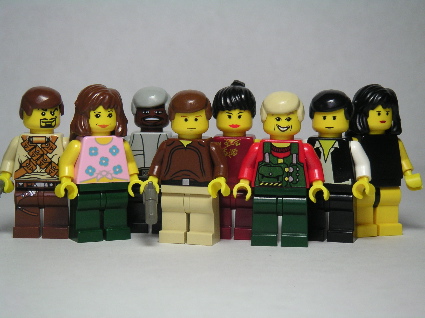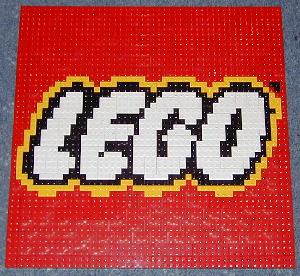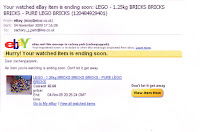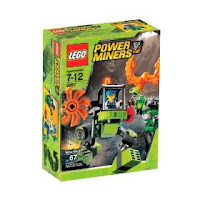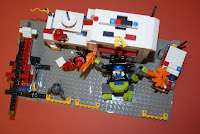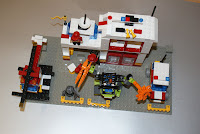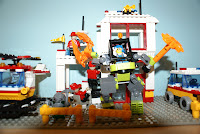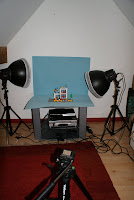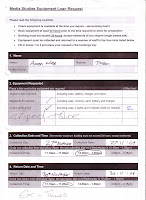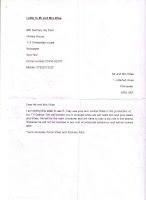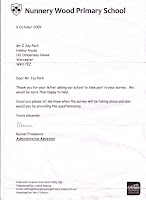Firstly, before I talk about my media product, take a look at this link I found on Youtube:
http://watch.youtube.com/watch?v=XaGh0D2NXCA&feature=PlayList&p=C3F64DE53C8F8AD2&index=6
From this link you can see that the text challenges forms and conventions of real 'media' products through:
- Lack of narrative structure
- Doesn't use continuity editing
- No recognisable generic conventions
- No Spheres of action
- Doesn't have conventional cinematography
- Very entropic, high degree of unexpectedness
The overall effect of this text is to put an unexpected effect on the audience, I thought very Carefully about this before making my media product and came to the conclusion I wanted to incorporate similar ideas and functions into my own text. I didn't want to be completely entropic as it would have a major effect on the target audience because they are so young and wouldn't understand my text. However I wanted to use a certain degree of entropy as I wanted to get the audience thinking about my media product and how it was unexpected. (Watch my directors commentary to find out how I created a balance of entropy and redundancy suitable for the target audience)
Now looking at a totally different playing field look at these too links, the first one being a Youtube clip I found and the second one a video of a butterfly I filmed when experimenting with entropic and redundant texts:
http://www.youtube.com/watch?v=ee3iuhJaA6A
The two clips are redundant, they are conventional and very typical. There is nothing 'unexpected' about them. The reason the first Youtube clip is so redundant is for one reason; making money.
It was very important for me to use redundancy in my media product as I wanted the largest target audience possible and to do that I had to stick to the 'rules' e.g. using Spheres of action. Also my media product was being made to be taken on by the BBC-CBBC which is very mainstream so it was important I used large degree of redundancy.
Creativity
I believe my media product is full of creativity, before even starting my Children's TV Drama I spent hours searching the web like Youtube, Lego links and real Children's TV dramas to make sure I wasn't going to be reworking an old idea as I wanted my work to be fresh and new so my target audience could see something never done before.
My ideas and framework for my AS coursework were very mainstream as I wanted to "play safe" so I could attract a large audience. However this year with mainstream still in mind I wanted to be a little more creative and experiment by mixing redundant and entropic ideas together; I know this can cause problems like my audience not being able to understand the text but I wanted to take the risk to see If I could create something successful from mainstream-niche ideas.
Technology helped my achieve creative goals as we wouldn't of been able to use Lego "Stop Frame Animation" if we didn't have the SLR cameras. They have played a huge part in this years coursework as with out them I wouldn't have been able to explore and achieve Stop Frame Animation and apply it with NVGS27 video cameras. Also last year there was a lack of communication with my AS work for feedback as I didn't have social networking sites like facebook. However this year technology has enabled me to use sites like facebook to communicate to friends about research,planning and ideas which allowed me to gain feedback so I could mould my work around their positive and negative comments and create audio commentary's on feedback which I've never done before.
Throughout creating my media product I never experienced whats known as "writers block" as I kept changing my ideas all the time to stay fresh and creative, I don't believe you can create a piece of work without changing it during the process. I had to stay focused and somewhat laid back on my ideas as I didn't want to get to attached to just one, I kept building on my work all the time until I was satisfied with the outcome.
I spent weeks before I knew what I wanted to do, I was always experimenting with ideas and getting feedback while other members of the group were already deep into their coursework but I knew I had to keep my mind wide open as that was the best option to take if I wanted to create a media text I had put all of my potential into. I had to know exactly what I was doing before I went on to actually do it that's why I think all the time I put into experimenting and using different creative ideas was the best way forward.
For the first time ever I moulded my work around my life outside college. I never knew how much ideas I could get through the simplest things in my social life for example my little brother who's 11 watches Children's TV Dramas and I was able to watch his reactions to different types of shows and ask him questions about them which helped me hugely when trying to appeal to my target audience. Being a football coach means I have to always change my teams tactics all the time to defeat the opponents and for the first time I used this technique to be creative and incorporate it in my work. Every week I would plan and change my ideas to overcome obstacles up ahead which worked and made me more aware and prepared for what I could and couldn't do.
Genre
Generic conventions are used in media texts all the time and I wanted to challenge some of the typical generic conventions. However I knew challenging generic conventions is sometimes pleasurable and sometimes problematic but I gambled and went for it. However I was careful in the way that I did this, I researched a theorist called Andrew Tudor and used the idea of building on a certain genre (In my case adventure drama) and creating a new sub genre to be born by mixing two genres together. I mixed a sci-fi action genre (LEGO) with a drama genre to create a totally new sub genre which would challenge generic boundaries. From looking at genre life cycles I would say my work comes under "Epic" as I have added new ideas into genre conventions that already exist and made sure they "fit" into the themes, ideology and values of the original genre.
The links below have helped me throughout the course and enabled me to understand and answer questions like this one:
http://www.mediaknowall.com/alevkeyconcepts/genre.html
http://en.wikipedia.org/wiki/creativity
My Directors Commentary
This is a basic overview of what is said in the directors commentary in a question and answer format:
Where have your ideas come from?
My ideas came from TV dramas like "Life on mars" and "Ashes to ashes" as I liked the idea of the changing of worlds and I found it very interesting and creative the way they constructed the idea of someone entering a new environment in a short title sequence. My ideas also came from Lego animation, after playing with the SLR cameras and watching Lego animation on sites like Youtube I thought it would be a great idea to create Lego animation as one of the two worlds in my work. Also most the ideas I used I came up with myself like the idea of getting lost and trying to find your way back home with the help of friends which I used in my narrative plot.
How different are your products to "real" media products?
With the limited amount of technology we had and on a very tight budget we didn't have the elements of a "real" media product like not creating our own sound effects so we had to get them off websites. However because my media product was created on the computer using professional programmes like photoshop and adobe premiere pro and because Lego is a media conglomerate and I have used it in my work it makes my work a "real" media text.
To what extent have you been original?
I believe I have been very original with my media product as I have taken two totally different genres and not colided them but "merged" them together. The idea of Lego as a TV programme is origianl as it has never been done before and then mixing it with everyday events to create a new sub genre makes it original on a even larger scale which I was aiming to achieve.
To what extent has entropy been used?
Entropy has been used a lot in my media text and it was important for me to use it to create the effect I wanted on the audience. The idea of a Lego superhero being turned into a human school boy is very entropic and keeps the audience unaware of whats going to happen next which creates a overall knock-on-effect of the audience wanting to carry on watching.
To what extent has redundancy been used?
I also used a large amount of redundancy as I didn't wanted the audience to get confused with the media text and therefore not enjoying it. As the target audience is young I had to use a lot of redundancy even tho I didn't want to! As the main character Jordan is turned into a school boy and its obvious that the narrative of the programme will involve a school. Plus I used "Spheres of action" and Toderov's theory of good vs bad to create a "easy" to understand text that the target audience would enjoy. I also used old ideas from other programmes like "My parents are aliens" where two worlds collide so the audience weren't being introduced to a text that is "alien" to them and so they will accept my text as they are familiar with its conventions.
What is the overall effect of using redundancy/entropy on the audience?
To create a media text that will appeal to a large target audience and for the media text to effect the audience in a way that will keep them interested and want to keep watching as they can relate the texts to their own personal life e.g. feeling lost at school like the main character Jordan.
Challenging forms and conventions is possibly dangerous, why?
It can cause the audience to be confused and not understand the text and therefore not enjoy it resulting in a rapid loss of viewers. If the audience don't understand the context of the media product there is no hope for moving forward with the media text. I had to remove certain clips from my media text like the earth poster in the school to illustrate the changing of worlds and a child development book Jordan holds indicating he is changing, however after showing these clips to our target audience they didn't understand them and asked why they were used so I thought It was for the best to remove the clips as I didn't want a confused target audience as they are only young and easily off put by texts they don't understand.
Following forms and conventions is possibly dangerous, why?
Giving the audience a media text that is very similar to other media products is very dangerous as the audience will find the text boring because its so similar and they will feel like they've seen it before therefore they will feel like its the same as everything and will not want to watch something that is so redundant. It was hard for me when creating my media product as I had to use a large amount of redundancy because of the age of the target audience without being to similar to other media products and using a certain amount of entropy to counter act the redundancy but at the same time not create a text that would confuse the target audience.
How were you inspired to do what you did?
I liked the fact I had so much creativity I could use and I used this to my best advantage to create a media product so unique it couldn't be paired to much other media products. I had plenty of ideas on inventing a character my target audience could relate themselves to and I built on this idea by adding Lego animation which is something Ive always been curious on doing. So being able to mix the two together was a bonus for me and I have not just created a media text that has achieved its aims but I have created something Ive always wanted to do and I have really enjoyed producing it.
How did your audience research direct your creativity?
Looking at a very young target audience meant I could be more informal and less mature in my ideas which I found new and interesting. I did a lot of experimenting and research into things Ive never looked at before like Children's TV Dramas. But the best part of being creative to a young target audience is the fact a child sees the world as a weird and wonderful place they want to learn from and explore so with this in mind I could create anything literally-as long as it appealed to them. When researching Lego, when I typed it into google thousands of results came up and as there aimed a young target audience very similar to mine it seemed like the perfect route to go down and with plenty of ideas already I could create a media product that would attract a very large target audience.
How did audience research direct your research into similar texts?
Researching for my target audience made me look at media texts with the same elements as mine like Tracy Beaker. I took ideas from these other Children's TV dramas which I looked at very closely and noticed they all had an effect on the target audience through the gratification approach. So when I was creating by media text I could apply the same ideas to get the same effect on the audience as the other media products did. Using the gratification approach I could make the audience connect with my media product through:
- Learning-The audience learn about school life and how to cope if its your first year or if your new to that school
- Escapism- If the audience enjoy school and don't have a stable life outside school they can use my media product to escape from that
- Social interaction- a very common effect that causes my media product to be a major talking topic at school
- Identity- Most media texts don't have this effect but I wanted to create a main character that my target audience could relate there own lives to. I tried to do this through making him the same age as the target audience and putting him though school life which every child has to face.
